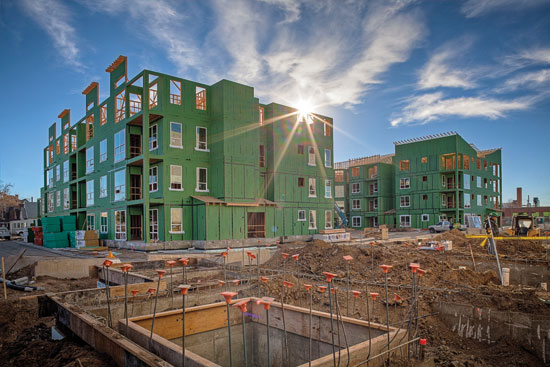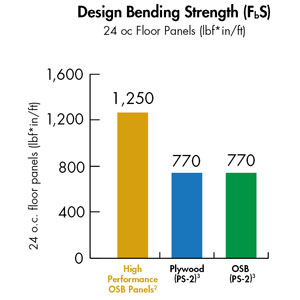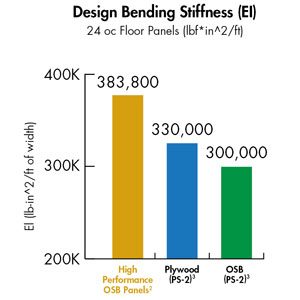Mitigating Risk with High-Performance Structural Wood Panels
Testing the Systems
ASTM E2273. Testing confirms that high-performance panels with integrated WRB and tape provide superior water management than traditional building wrap. Testing under ASTM E2273, the Standard Test Method for Determining the Drainage Efficiency of EIFS Clad Wall Assemblies, confirms that properly installed panels and tape perform substantially better than traditional building wrap offerings. Under third-party testing conducted by Architectural Testing, Inc, the integrated WRB sheathing/tape system achieved greater than 90 percent drainage, vs. the traditional sheathing/building wrap tape system, which achieved less than 10 percent drainage.
ASTM Water Penetration Test. In a test conducted using modified ASTM E3316 criteria, testers simulated a heavy 8-inch rain per hour with a constant wind of 35 mph on both an integrated WRB and tape system and a traditional building wrap, both properly installed to manufacturer specifications. The ASTM E331 test, the Standard Test Method for Water Penetration of Exterior Windows, Skylights, Doors, and Curtain Walls by Uniform Static Air Pressure Difference, is commonly used on window openings. For this test, however, it was modified to spray directly on the wall systems to examine how the fastener penetrations held up against water intrusion. In one test, a traditional building wrap was secured using the 1-inch crown staples recommended in manufacturer instructions, while the sheathing and tape system was installed with the recommended pneumatic framing nails. A separate building wrap test also was run using button cap nails, an alternative manufacturer-recommended fastener.
In both tests, the high-performance panel with integrated WRB allowed less water to penetrate the WRB system compared to the fastener penetrations of the traditional building wrap system. Using manufacturer recommended fasteners in the building wrap system, bulk water entered the staple holes created during the installation process, exposing the wood panel beneath the wrap to moisture. However, moisture exposure in the integrated WRB system was limited to the wood fibers directly around the nail heads and not the entire panel. Unlike the bulk water intrusion of the building wrap system, the integrated WRB managed the water exposure. In addition, no visible water entered the sheathing and tape system wall cavity.

Photo © 2013 Huber Engineered Woods LLC. Photo used with permission of Huber Engineered Woods LLC.
Integrated sheathing and tape systems help protect against air leakage while allowing sufficient vapor permeability.
As discussed previously, air leakage is also a concern, and many homes today now require blower door air leakage testing to confirm that their air barrier assemblies meet code-recognized performance targets. Using ASTM E2357, a common, standardized test method for measuring the air leakage of air barrier assemblies, third-party testing indicates that sheathing and tape systems provide a tighter air barrier assembly than traditional building wrap which, in this test, did not pass the standard required for recognition as an air barrier assembly. While the sheathing and tape system passed testing at seven different air pressure levels required under the code-recognized test methodology, the traditional residential building wrap failed at higher pressures, ripping or puncturing to expose the OSB surface beneath the wrap. Sturdier, more expensive commercial versions of the traditional building wrap were required to successfully pass the test.
Multifamily construction is following this trend toward tighter air barrier requirements. Beginning with the 2012 International Energy Conservation Code (IECC), 2012 International Green Construction Code (IgCC), ASHRAE 189.1-11 and ASHRAE 90.1-2010 all have requirements for air barriers. These codes and standards are all increasing the energy efficiency of buildings in many ways by requiring air barriers to seal a building from air infiltration and exfiltration.
IBHS Hurricane Effect on Integrated WRB and Taped Roof. Wind-driven water damage from hurricanes causes hundreds of millions of dollars in damage annually—a figure that can increase to billions when a hurricane makes landfall. In a first-of-its-kind test, the Insurance Institute for Business and Home Safety examined the comparative effects of a simulated hurricane on a roof deck that was sealed with tape and one that was not. Testing was performed on a fully furnished 1,300-square-foot duplex house with construction features representative of houses in hurricane-prone areas of the U.S. The structures were transferred to the 21,000-square-foot IBHS lab where 105 350-horsepower fans subjected the structures to several tests, including high-speed multi-directional winds and prolonged exposure to rain typical of hurricanes. Once the roof cover on the units blew off, researchers conducted a wind-driven rainstorm test for just over an hour which included rain in the amount of up to 8 inches of water per hour, typical of a hurricane situation. The difference between the unit with the sealed roof and the non-sealed roof was dramatic. In the non-sealed roof unit, in which there was no tape covering the seams between the layers of plywood or OSB sheathing, damage was substantial. The kitchen ceiling collapsed. The chandelier in the dining room fell from its mount and debris was widespread—in short this unit experienced the level of damage that would render it uninhabitable for weeks, if not months. Conversely, the unit with the taped roof deck suffered far less damage. This unit prevented substantial water from entering. As Julie Rochman, president and chief executive officer of IBHS, put it in a video presentation, “Sealing the roof deck will go a long way toward keeping wind and water out of the home.” 7
Florida Building Code Housing Testing Application Standard 100-95. In another third-party test conducted by PRI Construction Materials Technologies, LLC of a modified Florida Building Code Housing Testing Application Standard 100-95, Test Procedure for Wind and Wind Driven Rain Resistance shows that integrated systems and tape are more durable than traditional building wraps. The TAS-100 test as applied to roof application measures the ability of systems to resist water infiltration under wind. Modified for testing on walls, integrated WRB sheathing and tape systems remained intact and performed to the highest test setting while the traditional building wrap system failed under wind speeds between 70 miles per hour (mph) and 90 mph.
The Warranty Issue
In many cases, architects and builders use multiple systems from multiple manufacturers that require multiple layers of installation or application. For example, in traditional methods when sheathing is installed and the WRB installed at a later date, there is a gap in time where problems can occur, from overall exposure to covering misplaced protrusions or other openings in the structural sheathing. At best, this component or layered approach means there is a greater possibility of error among the systems, and at worst there is the potential for systems to work against one another to the point of voiding the warranty of one or more products.



© 2012 Huber Engineered Woods LLC. Photo used with permission of Huber Engineered Woods LLC.
The high-performance subfloor product carrying the ESR-1785 designation has been tested and reported to demonstrate higher strength, stiffness, and fastener-holding power design values than plywood and traditional OSB that only meet PS 2 code guidelines.
Footnotes:
1. ICC ES Evaluation Service Report ESR-1785.
2. Based on the equivalent specific gravity values published in ICC-ES Evaluation Service
Report, ESR-1785 and the 2012 APA Panel Design Specification, Form No. D510C.
3. ESR-1785 is an Evaluation Services Report (ESR) issued by the International Code
Council Evaluation Service. Evaluation reports from ICC Evaluation Service are
frequently used by code officials to verify that new and innovative building products
comply with code requirements.
4. 2012 National Design Specification for Wood Construction Manual for Engineered
Wood Construction.
Each manufacturer of each different layer has a specific set of installation instructions. If they are not followed specifically, there is the possibility of voiding the warranty on that particular component of the layered system. By contrast, in products where the WRB is integrated with the structural sheathing, a weather-tight seal is created simultaneously with the sheathing application when the tape is applied, minimizing the chance of errors. When it comes to considering warranties for roof or wall systems compared to two-step sheathing applications that require building wrap, there are great efficiencies in one warranty that covers moisture and air protection. Another point of differentiation is the warranty on various products—traditional building wraps typically carry a 10-year warranty, yet integrated systems can be warranted, for example, for 30 years, and may carry a 180-day exposure guarantee against extreme weather and UV exposure during construction.









